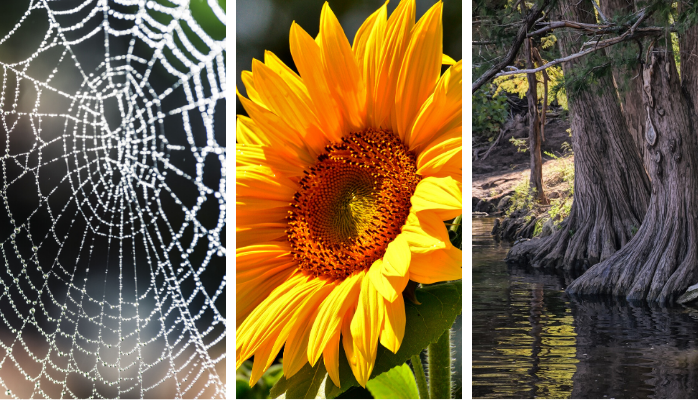
Geometric shapes. Intricate weaves. Spider webs form strong, complex structures that function as homes and food traps for the arthropods. Sunflower florets line up at just the right angle for each to get the right amount of sunshine. Tall, majestic cypress trees don’t just look amazing. They have “knees”—woody projections growing vertically from their roots—helping them stay healthy. Nature’s designs are worth paying attention to because they present biological solutions for environmental challenges.
Nature Inspired Design: Silk, Sunflowers, and Cypress
The silk that makes up a spider’s intricate web has properties that go beyond the practical needs of spiders for home and food. Founders of Bolt Threads recognized the built-in softness, high-tensile strength, and long-lasting durability and believed they could develop natural silks that mimic the natural proteins in spider webs. The result? Bio-
designed fabric that’s as durable and biodegradable as spider’s silk.
Designers of solar arrays ran into the challenge of panels being too close together and shading one another. That meant sometimes they had to be so spread out, they’d take up enormous acreage. When researchers at the Massachusetts Institute of Technology turned to nature for a solution, they realized if they mimicked the geometric positioning of a sunflower’s florets when they laid out the solar array, the problems went away. They could use less space, gain energy efficiency, and operate with better land management.
Less understood than spider’s silk or a sunflower’s florets, cypress knees—as I’ve discussed in a previous article—act as filters to break down waste into fertilizer and then convey nutrition to the rest of the tree. One reason this matters is the need for productive ecosystem solutions in built environments. We can study nature’s design in cypress knees and develop products that work like the trees to filter waste. It could be a flat disk at the bottom of a pond that filters heavy metals or a 1,000-gallon tank with bio-filters. The better we understand nature’s solutions, the better our designed solutions will become.
Bio-design in Built Environments
Built environments have faced sustainability challenges since we started relying on concrete and steel. A massive carbon footprint comes with those industries’ energy-intensive supply chains that burn fossil fuels and use excessive amounts of water.
To overcome these challenges, architects can take lessons from nature. When we’re working on a new design, that means asking, “How is this process accomplished in nature?”
For example, we’re studying the luciferin gene in fireflies. When the substance combines with oxygen and amino acids, it produces the light we see, (light that produces no heat) when fireflies fill up the night sky.The more we understand their lights, the more potential for developing rural lighting solutions that don't rely on cables. We could actually have nature inspired design that gives us greater security in rural areas.
We're also studying the calcium carbonate in conch shells and considering how to design and build sea walls with it. Calcium carbonate forms when conch shells and other sea animals pull carbonate from the ocean’s saltwater to combine it with their own calcium. The idea behind building sea walls with calcium carbonate is the saltwater will naturally help build the wall. We don’t have all the pieces to the puzzle yet, but if successful, a sea wall like this would be a carbon sink. Another biodesign that solves an environmental challenge.
Everyday lessons from nature are numberless, and designing more sustainable built environments depends on our ability to learn them well.
To find out more about how we look to nature’s design in our green architectural design services, reach out.

